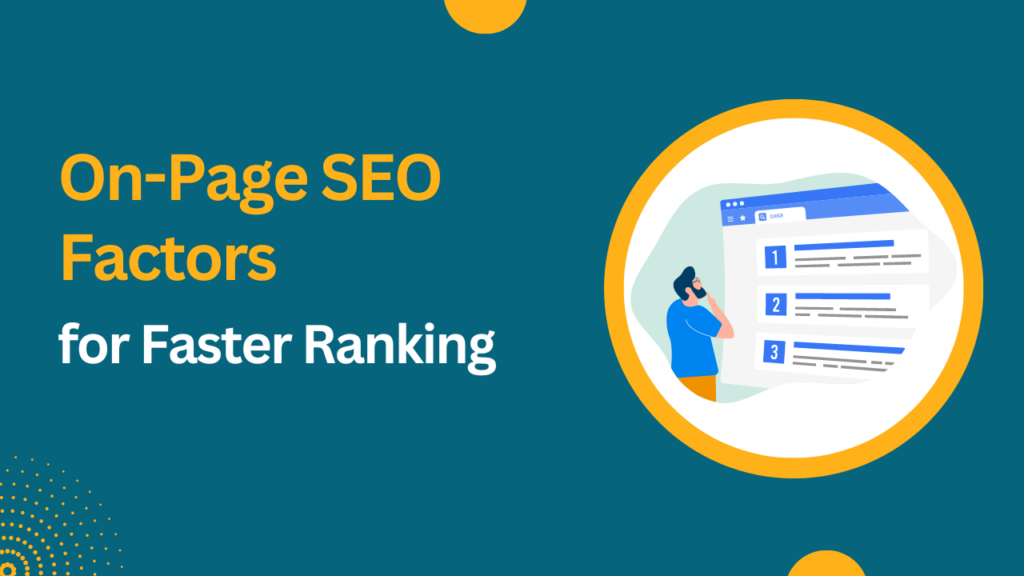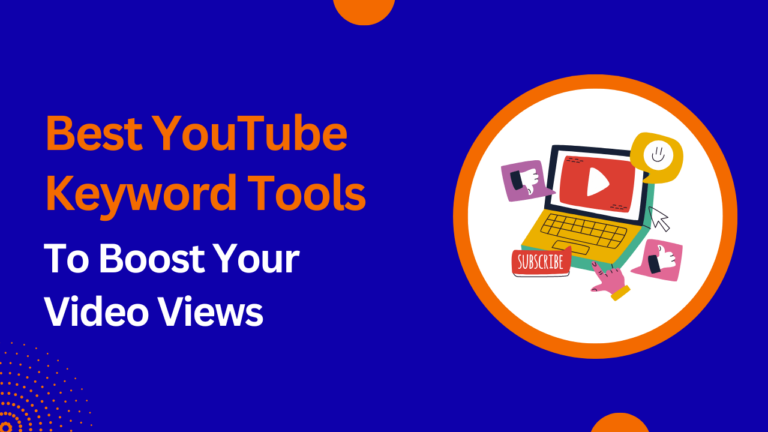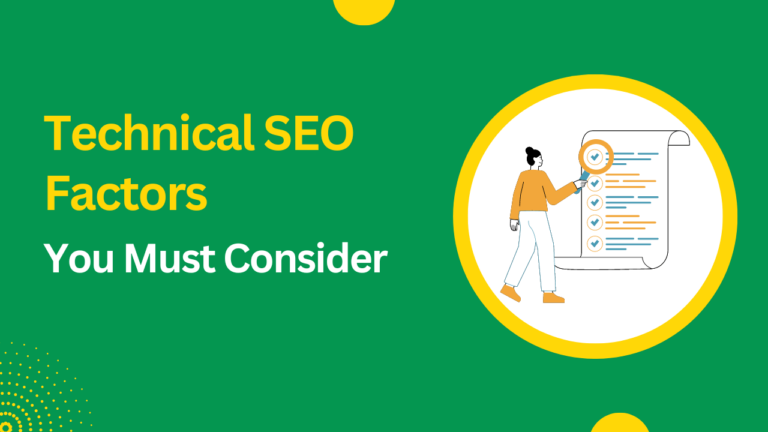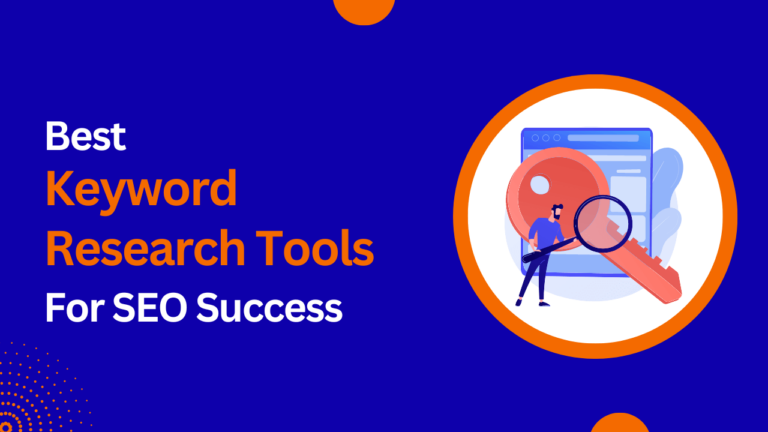Search Engine Optimization (SEO) plays a pivotal role in helping websites rank higher on search engine result pages (SERPs) and drive organic traffic. While there are various aspects to SEO, on-page optimization is a fundamental starting point for every webmaster.
Incorporating on-page SEO techniques into your overall SEO strategy is vital for long-term success in the digital landscape. By optimizing various on-page elements, you can enhance your search engine rankings, establish relevance, and ultimately drive more targeted visitors to your website.
In this blog post, I will discuss the most important on-page SEO factors that will empower you to optimize your website effectively. By implementing these techniques, you can enhance your website’s visibility and improve its chances of ranking higher on search engines.

What is On-Page SEO?
On-page SEO, also known as on-site SEO, refers to the practice of optimizing various elements within a website to improve its visibility and relevance to search engines.
It involves optimizing content, HTML source code, and technical aspects of a web page to enhance its search engine rankings and attract organic traffic. On-page SEO focuses on factors that you have control over directly on your website, making it a crucial aspect of any comprehensive SEO strategy.
Why is On-Page SEO Important?
On-page SEO is essential for improving your website’s visibility, attracting organic traffic, and providing a positive user experience. They help with:
- Higher Search Engine Rankings: On-page SEO techniques help search engines understand the content and relevance of your web pages. By optimizing your website’s on-page elements, you improve your chances of ranking higher in search engine result pages (SERPs). Ranking higher on the search engines help you with increased visibility, more organic traffic, and also potential conversions.
- Improved User Experience: On-page SEO goes hand in hand with enhancing the user experience. When you optimize your website’s content, structure, and usability, you create a better experience for your visitors. This includes providing relevant and valuable content, easy navigation, fast loading times, and mobile responsiveness. A positive user experience leads to higher engagement, lower bounce rates, and increased time spent on your site, all of which can positively impact your search engine rankings.
- Targeted Keyword Optimization: On-page SEO allows you to optimize your web pages for specific keywords and key phrases related to your business or industry. By conducting thorough keyword research and strategically incorporating these keywords into your content, headings, meta tags, and URLs, you increase your chances of ranking for relevant search queries. Targeted keyword optimization helps attract qualified traffic that is more likely to convert into customers or subscribers.
- Enhanced Content Relevance: On-page SEO involves creating high-quality, informative, and relevant content that meets the needs of your target audience. By focusing on content optimization, you provide value to your visitors and establish your expertise in your niche. When search engines recognize the relevance and quality of your content, they are more likely to rank your web pages higher, positioning you as a trusted source of information.
- Better Crawlability and Indexing: Optimizing technical aspects of your website, such as XML sitemaps, robots.txt files, and canonical tags, helps search engines crawl and index your site more effectively. This ensures that your web pages are properly discovered and included in search engine databases, increasing their visibility to potential visitors.
- Competitive Advantage: On-page SEO is an opportunity to outrank your competitors in search engine results. By implementing effective optimization techniques, you can differentiate your website and stand out among similar businesses in your industry. A well-optimized website that provides value and a seamless user experience can give you a competitive edge and attract more organic traffic over time.
What Are On-Page SEO Factors to Consider
Here are the most important on-page SEO factors to incorporate into your SEO strategy. By implementing these you can optimize your website effectively and improve its chances of ranking higher on search engine result pages.
1. Conducting Keyword Research
Keyword research is the most important element of any SEO strategy. Start by identifying relevant keywords and key phrases that are related to your website’s content. Use keyword research tools like Google Keyword Planner, SEMrush, or Moz’s Keyword Explorer to find high-volume keywords with low competition. Make sure to add these keywords naturally in your page titles, headings, meta tags, and body text.
2. Optimizing Page Titles and Meta Descriptions
Page titles and meta descriptions are crucial elements for both users and search engines. Craft compelling and keyword-rich titles that accurately describe the content on each page. Keep the title within 60 characters to ensure it displays properly on SERPs. Similarly, write concise and engaging meta descriptions within 160 characters, incorporating relevant keywords to entice users to click on your link.
3. Creating High-Quality and Relevant Content
Content is king when it comes to SEO. Develop high-quality, original, and informative content that addresses the needs of your target audience. Include relevant keywords naturally throughout the content, but avoid overstuffing. Break up the content with headings, subheadings, bullet points, and images to enhance readability and user experience. Aim for longer-form content whenever possible, as it tends to perform better in search rankings.
4. Optimizing Heading Tags
Heading tags (H1, H2, H3, etc.) provide structure to your content and indicate its hierarchy. Use H1 tags for your main title and subsequent heading tags for subheadings. Incorporate relevant keywords into these heading tags to help search engines understand the content’s context and relevance. This optimization technique also improves the readability of your content.
5. Improving Website Loading Speed
Website loading speed significantly impacts user experience and search rankings. Optimize your website’s loading speed by compressing images, minifying code, leveraging browser caching, and using a content delivery network (CDN). A faster-loading website enhances user engagement, reduces bounce rates, and increases the likelihood of higher search engine rankings.
6. Optimizing Images
Images are essential for enhancing user engagement, but they can also impact page load times. Make sure to compress your images. This helps to reduce their file size without compromising quality. Use descriptive file names and incorporate alt tags that include relevant keywords. Alt tags help search engines understand the content of the images, further improving your website’s visibility.
7. Creating SEO-Friendly URLs
A user-friendly URL structure is not only beneficial for search engines but also for users who want to share or remember your web page. Keep your URLs are short yet descriptive and add relevant keywords. Avoid using dynamic URLs with unnecessary characters or numbers, as they can make your URLs appear cluttered and less appealing.
8. Utilizing Internal Linking
Internal linking as the name suggests, refers to linking from one relevant page of your website to the other. This technique helps search engines understand the structure and hierarchy of your website, improves user navigation, and distributes link equity throughout your site. Include keyword-rich anchor text when linking to other pages on your website to provide context and relevancy to search engines.
9. Optimizing for Featured Snippets
Featured snippets are the highlighted search results that appear at the top of SERPs, providing concise answers to user queries. To optimize for featured snippets, identify commonly asked questions in your niche and create content that directly answers those queries. Use clear and concise headings, bullet points, and structured data markup to increase your chances of appearing in featured snippets.
10. Implementing Schema Markup
Schema markup is structured data code that you can add to your website’s HTML to help search engines understand the content better. By implementing schema markup, you provide additional context about your website, products, articles, and more. This can enhance search engine visibility, increase the likelihood of rich snippets, and improve click-through rates.
11. Optimizing for Mobile Devices
Mobile optimization is crucial as mobile devices continue to dominate internet usage. Make sure your website is responsive and mobile-friendly for a seamless experience across diffrent screen sizes. Optimize your website’s loading speed, use legible fonts, and make buttons and navigation elements easily clickable on mobile devices. Google’s Mobile-Friendly Test can help identify areas for improvement.
Monitor and Analyze Performance
Also, you must monitor and analyze your website’s performance using tools like Google Analytics and Google Search Console on a regular basis. These tools provide valuable insights into your website’s traffic, user behavior, organic search visibility, and potential issues. Monitor keyword rankings, click-through rates, and bounce rates to identify areas of improvement and adjust your on-page SEO strategies accordingly.
Conclusion
Mastering on-page SEO techniques is crucial for beginners to establish a solid foundation for their website’s visibility. By implementing these on-page SEO factors, you can enhance your website’s visibility, improve user experience, and increase your chances of ranking higher on search engine result pages.
Stay proactive, adapt to changes in search engine algorithms, and continue refining your on-page optimization techniques to achieve long-term SEO success.
Remember, search engine optimization is an ongoing process, and it’s essential to stay updated with the latest trends and best practices to maintain a competitive edge in the ever-evolving digital landscape.


